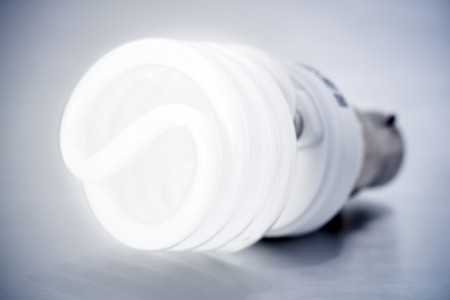By Matthew Van Dusen, Txchnologist
It’s a zombie myth that just won’t stay down: Compact Fluorescent Lamps contain toxic mercury. There is about as much truth to that statement as there is mercury in CFLS — which is to say, trace amounts. CFLs do contain mercury, but in quantities so small that breaking one exposes you, in most cases, to less mercury than eating tuna fish (see below). We consulted the EPA and contacted a lighting specialist from General Electric, which sponsors this magazine [Txchnologist], in order to take on the issue of mercury in CFLs.

How does mercury help produce light in CFLs?
CFLs are glass tubes that are filled with argon gas and mercury vapor. When an electric current passes through the tube, the mercury emits ultraviolet light that excites a phosphor coating on the tube. The coating then emits light.
Are we talking about high levels of mercury?
No. And the amount of mercury in CFLs has dropped steadily since they first made inroads into the market 15-20 years ago. As recently as 2007, CFLs contained about 5 milligrams, enough to cover a ballpoint pen tip. Since then, regulations in the European Union, which have also been adopted in California and other areas, have mandated that the amount of mercury in CFLs be limited to 3.5 mg by 2012 and 2.5 mg by 2013.
GE spiral CFLs use an even smaller amount: 0.8-0.9 mg of mercury. Sándor Lukács, the CFL systems manager for GE Appliance & Lighting, said the company decided to rapidly cut the mercury content of its CFLS in the 1990s. “To put it in perspective,” Lukács said, “when I was a little child, I had a thermometer that had 1,000 times more mercury than the current CFLs.”
Is there a replacement for mercury?
Scientists both inside and outside GE have used amalgams, an alloy containing mercury and one or more metals that can release mercury for discharge (amalgams have also been used in fillings). Lukács said GE researchers found that lamps without mercury had less efficacy, a measure of how well a lamp produces visible light, but some CFLs use amalgams as an alternative.
How do you dispose a CFL?
It’s against the law in several states – including California, New York and Connecticut – to throw CFLs in the garbage and it’s a bad idea everywhere. In the U.S., more than 1,700 Lowe’s stores take used CFLs and other recycling facilities can be found on Earth911.com. In the European Union requires, the cost of recycling is built into the purchase price and retailers must collect them from consumers
What happens to the mercury when the bulbs are disposed?
Mercury is in two forms in the lamp, solid and vapor. During the life of the bulb, the glass in the lamp consumes some of the mercury – up to 0.4 mg depending on the age of the lamp, Lukács said. Both the solid mercury and the consumed mercury can be recovered and processed for reuse in recycling facilities.
How do you clean up a broken CFL?
There’s no need to call the hazmat team. Still, the D.E.P. recommends leaving the room and ventilating it for 5-10 minutes. Then sweep up the broken glass and put it in a glass jar or a sealable plastic bag. The EPA advises against vacuuming broken bulbs because it can spread mercury vapor.
How much mercury are you exposed to when a CFL breaks versus, say, eating a tuna fish sandwich?
You may have missed this one, but an essay in the August 2009 issue (PDF) of LD+A, the magazine of the Illuminating Engineering Society of America, argued that people are exposed to far greater amounts of mercury by eating tuna fish. A typical 6 oz. fish sandwich contains 48 micrograms of mercury (that’s 0.048 mg), according to the U.S. Department of Health and Human Services. If you knock over a lamp and a CFL breaks, it will typically results in a dose of 0.07 micrograms (that’s 0.0007 mg) of mercury, according to scenarios assessed by the Maine Department of Environmental Protection. According to the authors, these numbers show that the issue of dangerous mercury in CFLs is “One Big Fish Story.”
![]() Editor’s Note: This story comes to us as a cross post courtesy of Txchnologist. Author credit goes to Matthew Van Dusen.
Editor’s Note: This story comes to us as a cross post courtesy of Txchnologist. Author credit goes to Matthew Van Dusen.